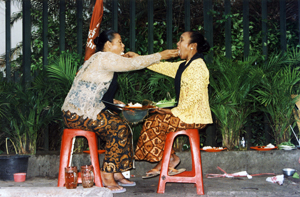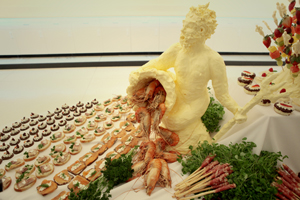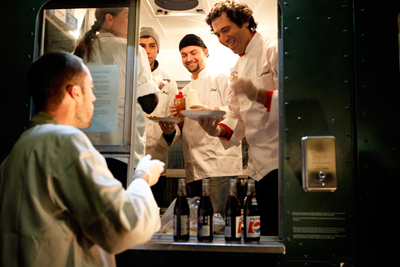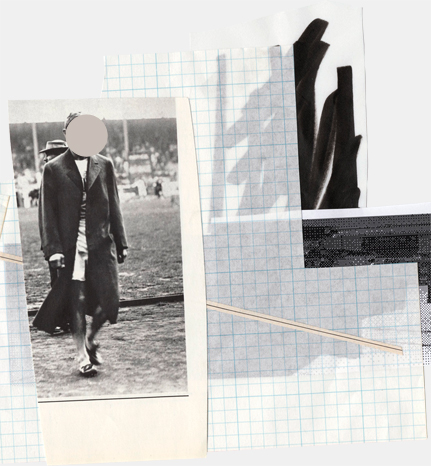


FEAST at the Smart Museum of Art
“Feast: Radical Hospitality in Contemporary Art” is dedicated to sharing food. The opening of the show at the Smart Museum on February 15 – boiling in relational aesthetics – reached and spilled over capacity early. There are not many things that I would be willing to wait for 40 minutes in the drizzling cold February weather, but the art-crowd appetite was well sustained as the long, hungry line of anticipation to the door was fed Iraqi cuisine (hummus with stuffed olive leaves) from Michael Rakowitz’s food truck “Enemy Kitchen.” Furthermore, the dish was effectively sprinkled with the delicious rumors that Marina Abramović was present inside. Given the unprecedented popularity of the show, I suppose the only thing hotter than pretension, which the art scene has been braised in, is free-flowing food.
Each of us, artist or not,
has experienced the magic of
cooking or being cooked for.
Upon entering I was greeted with “slatko” (strawberry jam) – a Serbian gesture of hospitality by artist Ana Prvacki – and mellifluous sounds of a live blues band. Inside the galleries, artwork ranged from writing about cooking to videos of various foods being made or consumed, to documentation of community activism projects. With work from over 30 international artists, the exhibition “examines the history of the artist-orchestrated meal, assessing its roots in early 20th century European avant-garde art, its development over the past decades within Western art and its current global ubiquity.”
The participatory nature of the show was foregrounded; much of the artwork is the documentation of ongoing Chicago-based eating projects. For example, a dinner table in one of the galleries is the installation “Dining Project” by artist Lee Mingwei, where guests are chosen in a lottery to dine with the artist in the museum after hours. Theaster Gates hosted the “Soul Food Pavilion” in a home, serving delicacies from Southern cuisine to a select audience in order to engage with political conversation within the comforting atmosphere of ritual, song and hospitality. Mella Jaarsma’s traveling performance “I Eat You Eat Me” hosts events around the world (many in restaurant settings) where people wearing colorful bibs order food and feed each other their meal across a small table. Throughout the duration of the show, the audience is encouraged to attend several events, concerts and symposia with appealing titles, such as “The Act of Drinking Beer is the Highest Form of Art,” on May 3.
The concept of sharing food is not original to “Feast.” Rirkrit Tiravanija has fed hoards of art-goers and Tania Bruguera infamously offered lines of cocaine to a conference audience in Bogota in 2009. Each of us, artist or not, has experienced the magic of cooking or being cooked for. But there were no haters at “Feast.” Instead, there was the sensuous pleasure of having the visual slip off the exhibition space and enter the “cavitas oralis” – you could contemplate things while chewing them. Again and again, there is something fantastic about the ability of relational aesthetics to break down the horrendous walls that separate the warring domains of concept and affect.
Yes, we love eating and drinking and interacting in the name of art, but the question remains: “What are we starving for?” I believe we are starving for the sweet taste of conceptual affect. “Feast” gives it away by the spoonful – get your fill.
Orchestrating a Feast: A Conversation With Stephanie Smith

Diana Buendía: Congratulations, I heard the opening of the exhibition was a big success.
Stephanie Smith: Yes, we had around 800 people here and the next night we had a crowd of about 1,000 people at Marina Abramović’s lecture at the First United Methodist Church [in collaboration with the Chicago Humanities Festival]. It was in a category beyond any of the openings we’ve had at the Smart Museum.
DB: Why do you think people are excited about the exhibition?
SS: Enthusiasm for this particular project is probably related to the fact that there are so many different kinds of communities that are touched by the local artists who are featured in “Feast.” I also think the nature of the topic is connected to the big changes in food culture in the United States over the last five years and an interest in the artisanal and the crafted. There are also questions about democracy and with whom we’re eating and how we connect to other people when we are moving so fast.
DB: How did the idea for “Feast” develop?
SS: One point of inspiration was a gift from my brother: the English translation of “The Futurist Cookbook.” In my own curatorial work over the past decade I have been focused on art that has one foot inside the museum and one foot out, so I know about a lot of artists who have been incorporating meals into their practice.
DB: Can you talk about some of the participatory events that are scheduled as part of the exhibition and how you approached their inclusion?
SS: Both Michael Rakowitz and Theaster Gates have international practices and their reputations are rising very quickly. They have opportunities to do projects all over the world, but they were both interested in the opportunity to do something here in Chicago where they live – shining a particular kind of light on this experience of being rooted here while speaking out to the world.
Lee Mingwei, on the other hand, is based in New York and will be coming to host a series of dinners for the “Feast” symposium. Mingwei has thought a lot about what it means to be a host and he takes that responsibility very seriously. He’s a great cook and he also asks about dietary preferences, and makes it a point to remind the guests that they will be eating without shoes so they should, for example, wear a good pair of socks. He acknowledges that eating at a museum with a stranger could be awkward.
DB: What do you think is the main message they should take from these participatory works, which are an intrinsic component of “Feast?”
SS: One of the things that I’ve really been concerned with as a curator is thinking about how elastic the space of the museum is. This is a show that, on the one hand, seeks to do what museums do well, which is to frame something out of everyday experience and help people make connections among things that they otherwise would not connect and to. On the other hand, I’m also interested in thinking about work that moves inside and outside – or entirely outside – the space of the institution and that is important to contemporary life and art. I’d be thrilled if people came away from this exhibition not only with a greater degree of understanding of the richness of participatory activity, but also a zone of activity that has an extensive history in art over the past century.
Feast: Radical Hospitality in Contemporary Art
Smart Museum of Art, University of Chicago
Through June 12
smartmuseum.uchicago.edu







